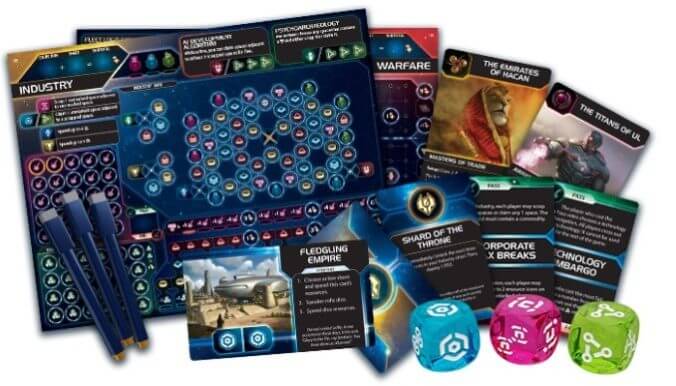Twilight Imperium is barely even a board game; with a listed playing time of four to eight hours, it seems more like a full-time job, although I concede that I have never played it because I don’t have that kind of time or attention span. It’s ranked in the top five all-time on Boardgamegeek, however, and its fans are quite ardent. I’m very used to seeing gamers walking around Gen Con every year with Twilight Imperium in a giant bag that looks like it might lead to a separated shoulder.
Anyway, we now have a roll-and-write spinoff of Twilight Imperium, with the clever title Twilight Inscription, which I doubt gets you the full Imperium experience but does promise to get you to bed before sunrise. It’s the most complex roll-and-write game I’ve ever played, with players marking spaces on four separate scoresheets, but if you enjoy the roll-and-write format, especially the way you can chain bonuses in good ones (like That’s Pretty Clever or last year’s Three Sisters), this does that… but in space.
In Twilight Inscription, you and up to seven of your closest friends will explore new star systems, develop your industry, and wage war on each other, all with dry-erase markers and six dice. Three dice are black and are usable by all players at all times, while the other three are red, green, and blue, and must be unlocked once for each of your four scoresheets.
Turns begin with an Event card applicable to all players, which may make this a dice-rolling round, a War round, or a Council round. In the dice-rolling rounds, each player chooses one of their four score sheets to mark in that round, and may get a few free actions based on the icons on the event card. One player does all the rolling, as there’s no ‘active’ player in this game, after which everyone uses all of the dice they’re eligible to use. Most die faces allow you to cross off one or two spaces, but each of the scoresheets has some unique features that make the different symbols work differently. On the exploration board, for example, two symbols allow you to explore to the next node out from where you’ve already been, but the third symbol lets you claim a planet or reward that you’ve reached. On the industry board, two symbols let you ‘scrap’ or cross off spaces on the large grid, while the third symbol lets you circle a space adjacent to anything you’ve scrapped or circled before.

When the event is a War card, players will compare the nodes they’ve marked off on their war sheets to those of their neighbors to the left and right (or to the AI in a solo or two-player game), similar to the mechanic in 7 Wonders. When the event is a Council card, players cast as many ballots as they like up to the number they’ve unlocked on their Industry cards, choosing to vote for or against whatever the proposal is on the Agenda card for that round.
It’s a lot, as you can tell, and compared to most roll-and-writes, it’s harder to learn and harder to play. (The rulebook is nowhere near detailed enough to explain everything that’s going on, either.) There are a slew of icons to learn, and the reference in the rulebook didn’t answer all of my questions. It wasn’t clear to me for several rounds, for example, that you could unlock a “focus” bonus, allowing you to use one of the colored dice on a specific sheet, by marking a space on one sheet and then unlocking the die on a different sheet.
The complexity in Twilight Inscription isn’t so much in the rules as in the number and difficulty of the decisions you have to make over the course of the game. You can’t complete everything, or even complete any sheet, most likely, so you’re making choices from the start that will affect your strategy and powers for the rest of the game. You’ll have to focus on probably two of the four sheets, but you can’t ignore the remainder, either, as they’re balanced well enough to ensure you have to mark some spaces on all of them. The Warfare sheet is both the most arcane and the most clever; the way you choose how to mark off nodes, by using symbols to build different shapes of military units you draw on your military grid, is extremely unintuitive, but the way the battles score means the best war strategy is to just barely win your battles. There’s no bigger bonus for winning by a lot; you get the same reward if you win in war by one point or by five.
I recognize the care and calibration that went into this design; most roll-and-writes are simpler across the board, but even playtesting a game as complicated as this one has to be a substantial undertaking. That said, despite the game’s brilliance, it’s also not to my personal tastes. If I want to play a roll-and-write, I’m looking for something faster and simpler; if I want to play a 90-120 minute game, I’m looking for something crunchier like a worker-placement game. But if you want an “epic” roll-and-write experience, or something with the vibe of Twilight Imperium in a playing time you don’t have to measure with a sundial, Twilight Inscription might be right up your alley.
Keith Law is the author of The Inside Game and Smart Baseball
and a senior baseball writer for The Athletic. You can find his personal blog the dish, covering games, literature, and more, at meadowparty.com/blog.
